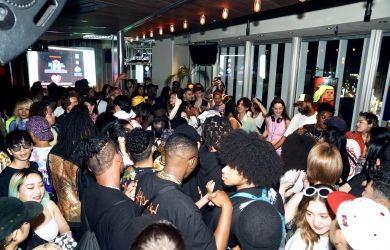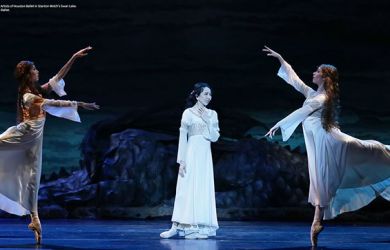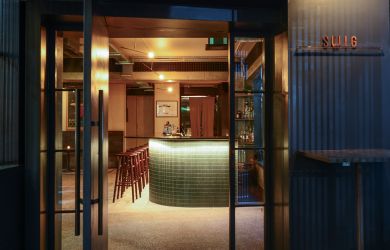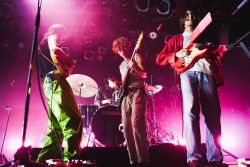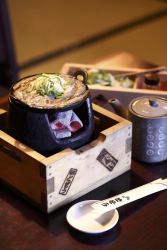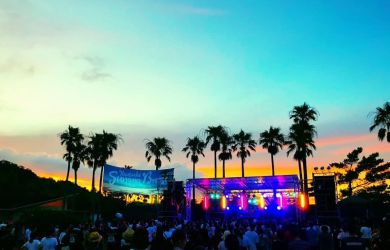
February 19, 2004
The Hill is Alive
Grab your coats and your wallets for a tour of the best of Osaka with local boy Simon Rowe.
By Metropolis
Originally published on metropolis.co.jp on February 2004

Photos by Simon Rowe
Mokarimakka means, “are you making money?” and it’s not hard to see why this is the standard greeting between the citizens of Osaka. Wander up through Namba precinct, located in the south of the city where the alleyways brim with cheap and lively izakaya, cross over the Dotombori River into Shinsaibashi and you can almost hear the rustling of cash changing hands. Thousands of restaurants, bars and clubs fill with hungry Osakans here each evening.
Osaka means “big hill,” yet from Umeda Station in Kita (north Osaka) to Namba Station in Minami (south), the cityscape is as flat as a teppanyaki grill-good news for anyone who suffers the claustrophobia of subway systems. Indeed, the last place you want to be is tucked under someone’s armpit is in a crowded subway car during rush hour. Avoid these times (7-9am, 6-8pm) and nearly all the recommended sights below can be reached easily within 10-15 minutes from either Umeda Station or Namba Station.
Amerika-mura
“Amemura,” as Osaka’s laid-back youth call it, begins west of Shinsaibashi subway station and stretches all the way from Nagahori-dori street down to the Dotombori River. It’s here you can join the sheer chaos that reigns on weekends when more than 200,000 cashed-up and clothes-hungry youth flood into the maze-like streets and alleys to pick through some 3,000 shops purveying everything from Balinese sandals to Boston bowling club jackets, Zippo lighters to zebra-striped g-strings. South: Nearest stn: Shinsaibashi.
Shitennoji Temple
Hot on Osaka’s temple trail is Shitennoji, founded in 593 AD and said to be the oldest imperial temple in Japan. Understandably, the oldest wooden pavilions date only from 1623, fire having claimed all the originals. Peace and calm prevail on most weekday evenings-the best time to enter through the stone torii gate and join the faithful as they worship the setting sun through the West Gate. You can also check out a series of elaborate fan-shaped paintings depicting the frugal lives of Osakans during the Heian Period (794-1192), before praying for the “pure land paradise,” which is said to lie in the West. South: 1-1-18 Shitennoji, Tennoji-ku; Nearest stn: Shitennoji-ma.

Kinryu Ramen
For the peckish, that “paradise” might be Kinryu. Harrison Ford stopped here for a bowl of Golden Dragon noodles during the filming of the sci-fi classic Blade Runner and there are photos tacked to the rafters of this cozy street stall to prove it. Simply step up to the vending machine, insert your ¥800, punch the button and hand over your ticket. Within minutes, one of the orange-haired teenage staff wearing a red dragon shirt will have a steaming bowl of brothy miso ramen under your nose. Sit at the counter or one of the low tables for a great view of the passing throngs. South: 100 meters east of Dotombori bridge; Nearest stn: Shinsaibashi.
Den-Den Town
Nowhere do store shelves groan so heavily with the latest gizmos than in Den-Den Town. It is a place of perpetual brightness: neon signs sizzle, strobe lights dazzle and an excess of fluoro-tubes turn every store into a heavenly shopping experience for the thousands of tech-heads, cyber-junkies, PS2 jockeys and tourists who swarm in on weekends. New and used software, cheap digital cameras, J-pop CDs and a myriad of other hi-tech knick-knacks can be snapped up in the crowded aisles of popular stores like Fanatic Computer, ScoopLand and Faith. A credit card-sized AM-FM radio in Mount Fuji and geisha designs? A 10,000-volt Electroshocker, or a set of Takara’s solar-powered jelly fish? Whatever your budget, it’s a souvenir hunter’s heaven. South: Nearest stns: JR Namba or subway Nippombashi.

Sumiyoshi Taisha Shrine
At the risk of getting “shrined out,” this one should be high on the list of must-sees, if not for its four beautiful pavilions then for its role as Osaka’s spiritual caretaker. Legend has it that an empress named Jingu once traveled to Korea under the protection of three gods and on her safe return to Japan founded this shrine as a special thanks to her guardians sometime in the third century. Sumiyoshi has since held special significance to mariners, fishermen and traveling merchants, and its roughly 700 stone lanterns testify to the shrine’s “prosperity-generating” powers. South: 2-9-89 Sumiyoshi, Sumiyoshi-ku; Nearest stn: Nankai line, Sumiyoshi-Taisha stn.
Osaka Prefectural Gymnasium
This is the place to watch the big boys rumble for the first two weeks every March. Prime viewing seats sell out fast mainly through the incomprehensible advance-purchase mail-order system. However, getting your hands on ¥4,100 isu-seki single seats, located further back from the dohyo (ring) and ¥1,400 tachimi-seki (standing tickets) is easier if you buy directly from the gymnasium box office, open from 9am-4pm on the day of each event. The top division bouts last only two hours, from 4-6pm, but there is no shortage of sumo rice crackers, posters and souvenirs on sale to help you remember the moment. South: 3-4-36 Namba-naka Naniwa-ku; Nearest stn: Namba.
Osaka Castle
Nothing better represents Osaka’s rise from feudal kingdom to buzzing hub of international trade than Osaka castle park. An oasis of cherry and plum tree-lined boulevards and water-filled moats, at the center of which stands Osaka castle, is the last thing you’d expect to find in a sea of ferro-concrete. Of special interest is the castle’s central dojon, or tower, where a museum screens epic 16th-century samurai battles as 3-D laser shows alongside exhibits of the original pitted and dented armor used in those very skirmishes. Open 9am-5pm, adm ¥400. North: nearest stns: Temmabashi, Tanimachi 4-chome or Morinomiya.
Umeda Sky Building
The “Arc de Triomphe of Japan,” some call it. Indeed, any feeling of triumph comes only after you brave the vertigo-inducing escalator ride between the Sky Building’s two main towers. To ease one’s mind and take in the fabulous city night view, head for the Floating Garden Observatory (open 10am-11:30pm, adm ¥700). North: 1-1 Oyodonaka, Kita-ku; Nearest stn: Umeda or Hanshin.
Shimizu-yu Bath House
Before departing Osaka, ease your swollen feet with a visit to this wonderfully local bath house in Amerika-mura. Enter and an elderly cashier will relieve you of ¥300 and direct you to the second-floor changing rooms. Be advised: Before getting into the wonderful brimming tubs, you must undertake the curious ritual of riding an elevator to the third-floor bath room-naked! South: 1-4-18 Nishi-Shinsaibashi, Chuo-ku; Nearest stn: Shinsaibashi.
Getting there
JAL and ANA operate several flights a day between Haneda airport and Osaka. Bullet train services leave Tokyo station hourly for Osaka and beyond.
Where to stay and more information
The Osaka City Visitors’ Information Center has offices at both Shin-Osaka and Osaka stations. They provide accommodation listings, city maps and train timetables. Their English-speaking staff can also recommend restaurants with plenty of local flavor. For more information, visit www.tourism.city.osaka. jp/en/index.htm
[geo_mashup_map]
